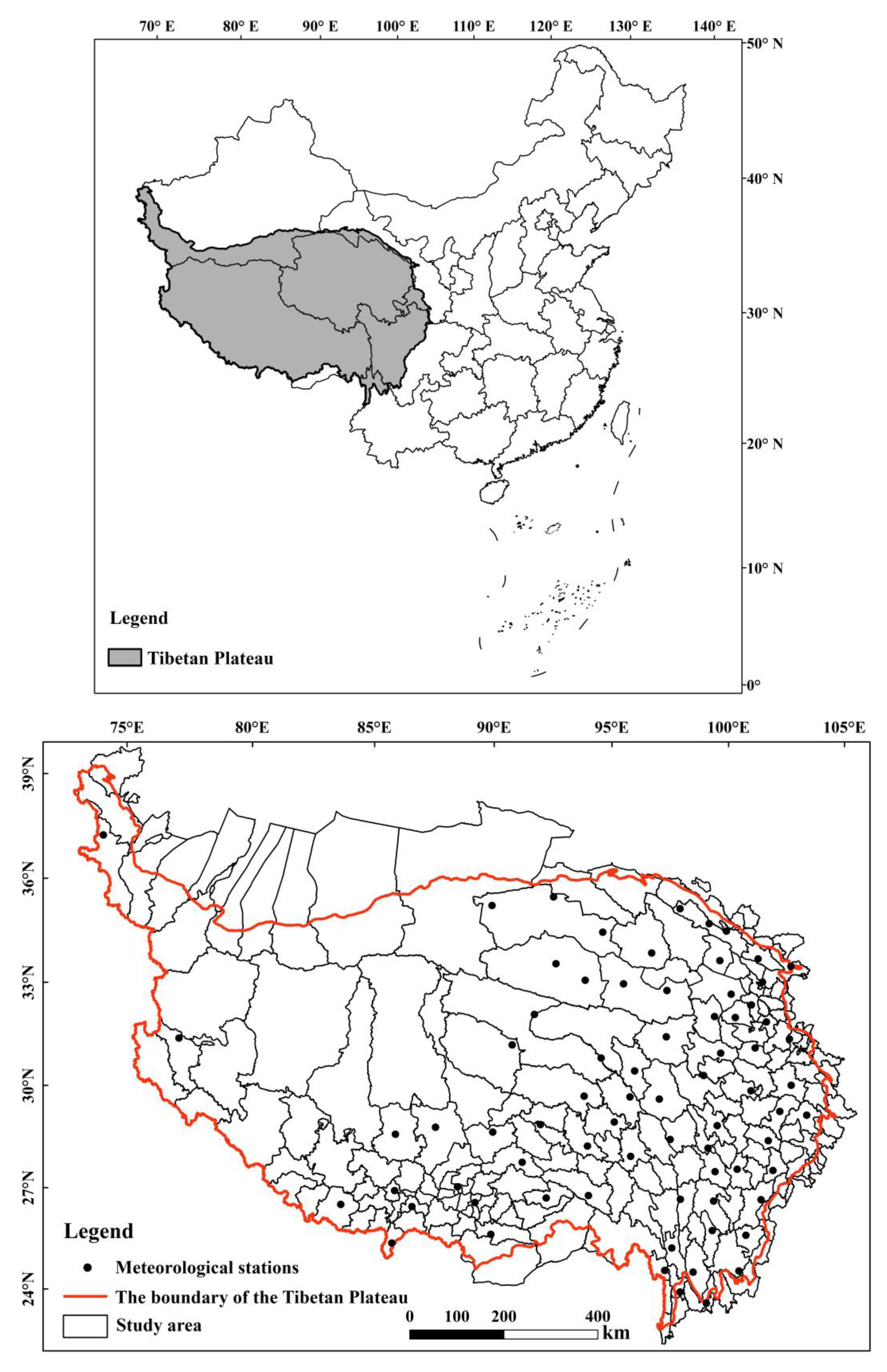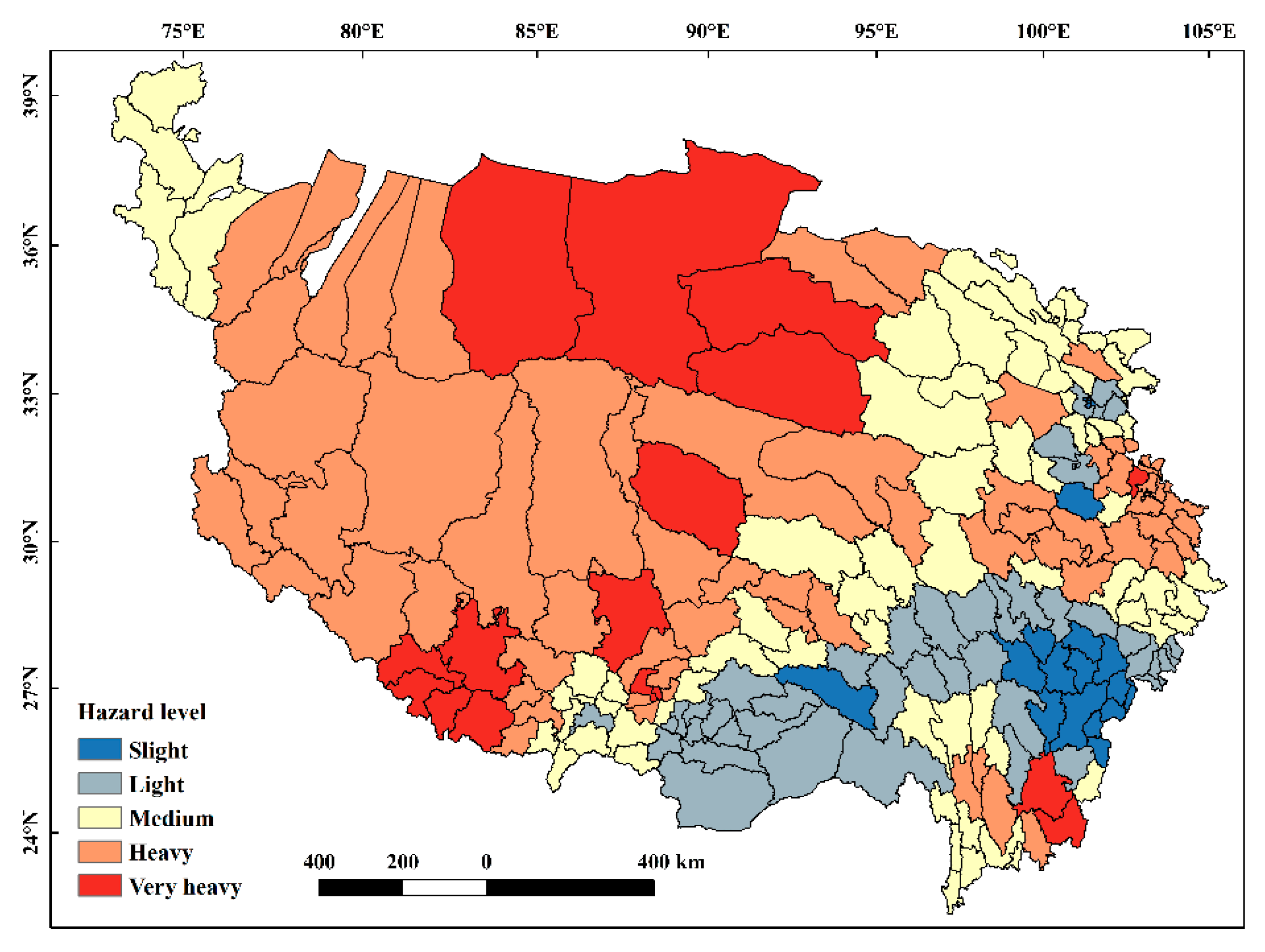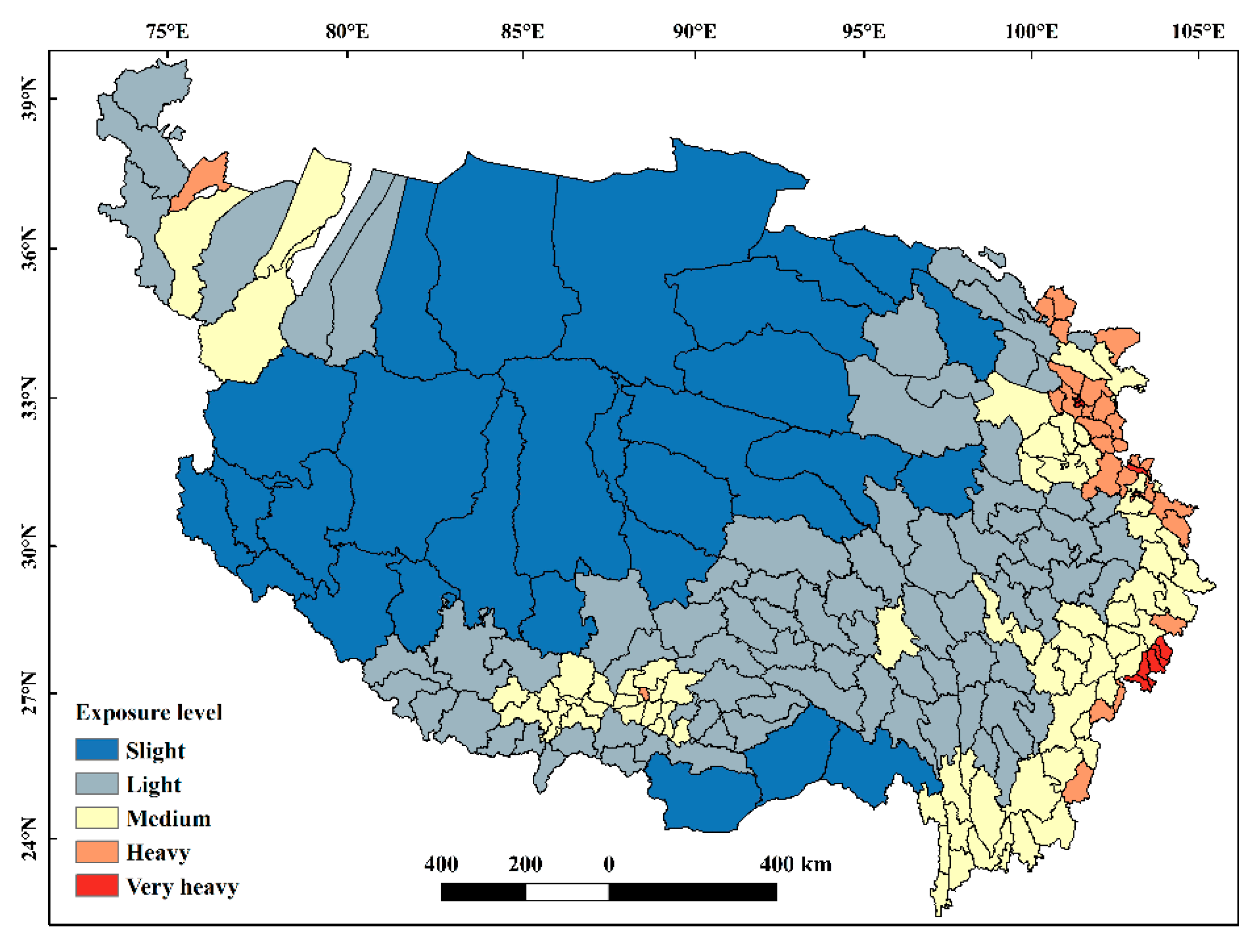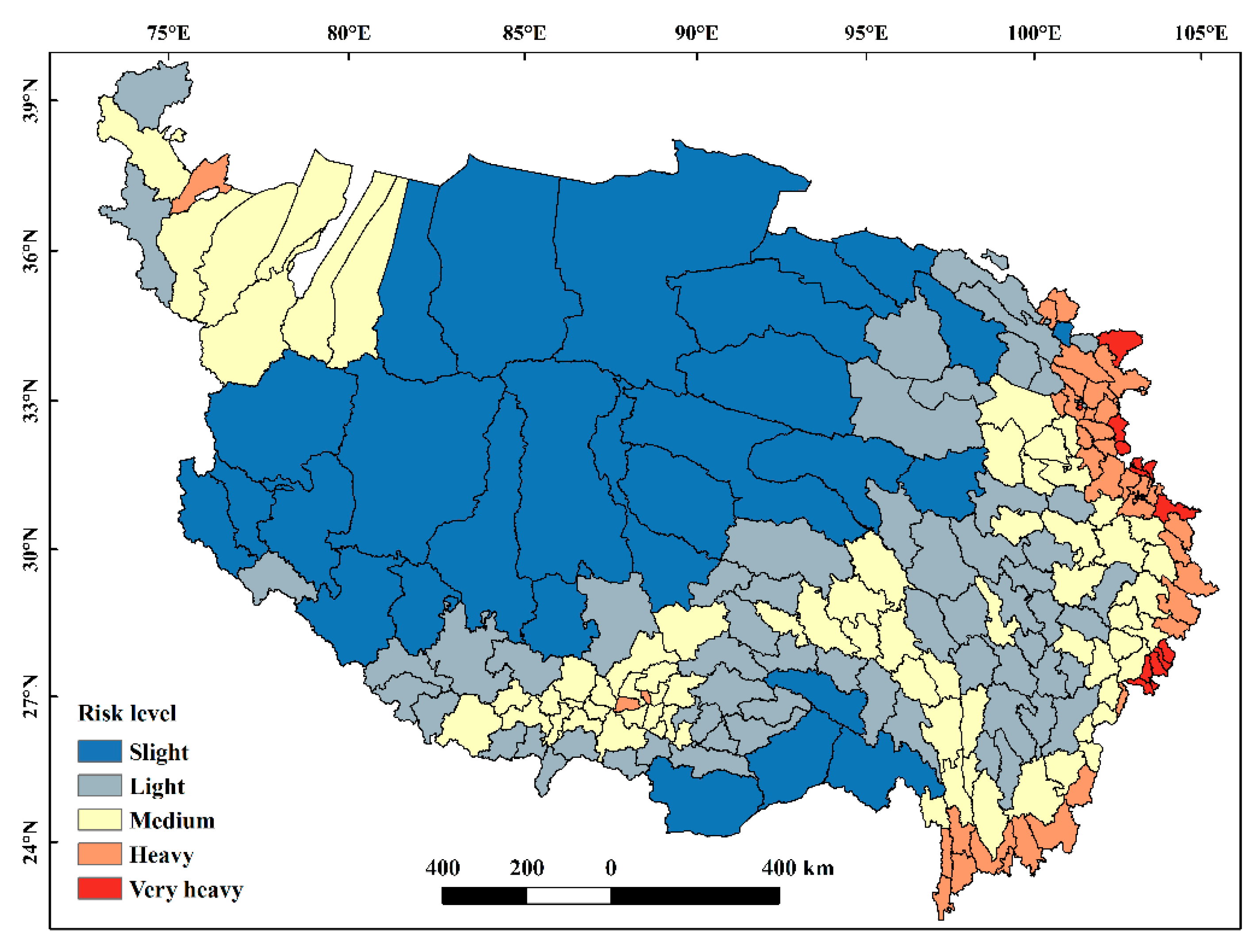1. Introduction
In the past few decades, most regions have experienced obvious warming, with a global average combined land and ocean surface temperature increase of 0.85 °C (0.65–1.06 °C) during 1880–2012 [
1]. The persistent rise of temperature also altered the global hydrological cycle and weakened its stability [
2,
3], resulting in extreme events occurring more frequently, while the global trend of precipitation was unstable [
4]. In China, the temperature of the land area increased by 0.90–1.52 °C from 1913 to 2012 [
5], which was obviously higher than the global increase rate, and the overall tendency of precipitation showed no significant increase or decrease [
6,
7]. How much impact these climate factors have affected humans and what adaptation measures should be taken have been hotspots of global climate change research [
8,
9,
10,
11,
12,
13,
14].
Growing evidence reveals that the impact of climate change on human security is multifaceted. Firstly, extreme events such as droughts and floods provoked by climate change can directly cause casualties [
15]. Secondly, climate change could harm health by increasing infectious and non-communicable diseases [
16,
17]. At the same time, climate change indirectly affects human security by economic losses [
10], population migration [
18,
19], war, and conflict [
20]. To sum up, climate change has posed a serious challenge to human beings, and the challenge in most regions of the world will become more and more intense in the middle and latter period of this century.
In this wide context, the risk posed by climate change is highly concerning and has become a fast-growing field in climate change research [
21,
22,
23]. This covers a wide range of contents, and different organizations or institutions have different understandings [
24,
25]. In the AR5 of IPCC, it was pointed out that the risk caused by climate change is the result of the interaction of hazards and the vulnerabilities of exposed elements, and would signify the severe interruption of the normal functioning of the affected society [
26]. The population risk refers to the combination of the possibility, degree, and consequence of the adverse impacts of climate system change on a population. At present, the studies concerning the impact of climate change on human beings do not specifically target population risk, but only involve it in the overall picture. Existing studies mainly focus on the disaster risk of specific extreme events. Taking floods as an example, Agrawal et al. [
27], Jadot et al. [
28], and Assis et al. [
29] studied the flood disaster risks in Uganda, France, and Brazil, respectively. All the study contents involved population, an important risk-bearing body, and the factors considered included population density, residential area, public perception of risk, and so on. Taking heat waves as another example, Harlan et al. [
30], Tan et al. [
31], and Tomlinson et al. [
32] studied the impact and risk of heat waves on populations from different angles, and found that the age structure, population density, education level, and exposure location can influence the risk to a certain extent. Throughout the existing studies, whilst the impact of climate change on populations and population risk to climate change have been of wide concern in the research community, disaster risk is still the mainstream paradigm. While the importance of sudden-onset risk cannot be overemphasized, and recent research insights provide that slow-onset risk cannot be ignored [
33], very few studies have been done to assess the slow-onset risk to climate change, especially for the slow-onset risk on populations.
The Tibetan Plateau (TP) is located in the core area of the Earth’s “Third Pole”, known as the “roof of the world” and the “Asian water tower” [
34]. In the past few decades, the climate over the TP has undergone significant changes. The annual temperature rise rate of the TP was 0.30 °C · (10a)
−1, the annual precipitation increased by 6.59 mm · (10a)
−1, and extreme weather and climate events have accelerated and enhanced [
35,
36,
37]. These variations have a serious negative impact on the health and safety of the population [
34,
38,
39]. To make populations more resilient to the risks posed by climate change, local governments should urgently and realistically consider measures and strategies needed to help populations adapt to the adverse effects, and at the same time, consolidate the achievements of “targeted poverty alleviation”. Based on the review of the literature to date, the study of climate mean variation over the TP has advanced. The research objectives included the spatial-temporal distribution and dynamic change of the mean value [
40,
41], and the study area involved the Three-River Headwaters Region [
42], Qaidam Basin [
43], and other typical areas. As a response to the concern created by extreme weather and climate events, the research objects have included extreme temperature and extreme precipitation, and the study areas involved the western, eastern, and central TP, and other regions [
44,
45,
46,
47,
48,
49]. The current research on climate variations still lacks the combinations of trends, fluctuation characteristics, and extreme events. Some researchers have also discussed the risk of droughts, snow disasters, and other events over the TP [
50,
51], but only extreme or disaster was employed to represent the risk, while the risk-bearing body is not considered. Other researchers tended to build risk evaluation models, also for specific disasters, and the risk-bearing body was mostly concerned with the animal husbandry system [
52,
53,
54,
55]. Due to the different research directions and focuses, they pay more attention to grassland and livestock when considering exposure and vulnerability factors, while we would focus more on the population-related indicators. In addition to this targeted research, global- and national-scale risk studies have also involved the TP. However, due to the identical criteria and vast study area, the risk on the TP was always in a single level, which is different from the actual situation, and makes it difficult to show internal spatial differences [
56,
57]. What’s more, the lacking and missing regional socioeconomic data has made it “No data” in some studies, and missed the comparison with other areas.
Taking the above situation into consideration, this research attempted to (1) systematically assess the hazard from new perspectives of the combinations of trends, fluctuation characteristics, and extreme events; (2) reasonably evaluate the population exposure and vulnerability from the aspects of population scale and structure; and (3) comprehensively quantify the population risk to climate change, display the spatial pattern of the risk, and reveal the key influencing factors. The findings are of vital benefit for enhancing the understanding of population risk over the TP to climate change, improving the ability of risk prevention and mitigation, and providing scientific support to guarantee sustainable development.
The paper is structured as follows:
Section 2 outlines the study area, data, and methods. In
Section 3, the results are demonstrated and described. Finally, the main conclusions and discussion are presented in
Section 4.
4. Conclusions and Discussion
There emerged a significant climate change over the TP during the past decades. More and more serious impacts induced by the changes were threatening the safety and health of the population on the TP. A study on population risk to climate change would be helpful to improve the cognition of risk and provide a basis and support for local risk prevention. This research first evaluated the climate change hazards including trend, fluctuation, and extreme changes of air temperature, precipitation, and wind speed, then the population exposure and population vulnerability over the TP. Finally, the population risk to climate change was quantitatively assessed by using the risk conceptual model. The spatial pattern of population risk was demonstrated, and the key controlling factor of population risk was found. The following conclusions can be drawn from the results.
The hazard of climate change over the TP was mainly at medium and heavy levels, and the area of counties with medium and heavy hazards accounted for 64.60% of the total area. Spatially, the hazard was higher in the western than in the eastern TP, and higher in the northern than in the southern regions. The change in temperature was the major factor influencing climate change hazard, and its contribution reached 48.54%.
Over the TP, the population exposure to climate change was generally low, and the land area at slight and light exposure levels accounted for 83.94%. The population exposure showed a relatively high level in the eastern margin and low levels inside the TP, for which the counties in Xining city and Western Sichuan were the highest.
The population vulnerability over the TP was mostly in the medium and heavy levels. Spatially, the vulnerability of the eastern margin and northwest of the TP was relatively high, and in the central and northern parts it was low. The non-agricultural population rate was the key factor affecting the population vulnerability over the Plateau, and its contribution reached 33.82%.
The population risk over the TP was the combination of the above-mentioned climate change hazard, population exposure, and vulnerability, and was generally low over the past decades. However, only 24.44% of the population was distributed in the low-risk areas, with 74.52% of the total area. On the contrary, 41.41% of the population was concentrated in the very-heavy- and heavy-risk areas, with less than 5% of the land area. The population risk to climate change was high in the eastern edge area and low in the inner region of the TP. The population risk was the slightest in the contiguous regions of Western Tibet and southern Xinjiang, and the heaviest risk was in counties of Linxia Prefecture in Gansu and western counties of Chengdu and Deyang in Sichuan. Among the three elements of hazard, population exposure, and vulnerability, population exposure was the decisive factor of the population risk to climate change.
The assessment on population risk to climate change is still in the exploratory stage, the theoretical basis and methods are still not perfect, and many deficiencies must be further studied. For example, the meteorological station data in this research has better time continuity, but the reanalysis dataset has stronger spatial continuity. The combination method of observation and simulation in future research is a powerful approach to solve the sparsity of stations on the TP and reduce the uncertainty of hazard assessment. The population data was obtained by on-site collecting, which improved the availability of data in Tibet and other data shortage areas and ensured the credibility of the results. However, the slow development of statistical work and the scarcity of statistical item settings affected the population vulnerability assessment to a great extent, which led to the connotation of vulnerability not being fully demonstrated. In future studies, we need to speed up the construction of the socioeconomic database and supplement other factors that determine the population vulnerability. In addition, this research comprehensively analyzed the current risk, which has laid a solid foundation for risk prejudgment, but far from enough. Using RCPs (representative concentration pathways) and SSPs (shared socioeconomic pathways) scenarios to project and evaluate the spatiotemporal pattern and evolution of risk in the medium- and long-term of this century is the important direction in climate change research.
The ultimate goal of the risk assessment is to develop appropriate mitigation strategies. From the results in this paper, three policy suggestions that may be useful in risk management and adaptation over the TP can be presented. (1) Strengthen meteorological observation, establish a satellite-aerial-ground-based dynamic observation system, broaden the scope of meteorological services, and enhance the cognition level and predicting ability of climate change over the TP. (2) Establish a disaster prevention and mitigation warning system for special environmental areas with the consideration of extreme events, and improve the existing emergency management system. (3) Intensify education of risk, increase the diversity of residents’ livelihood, amplify the social service network, and improve risk-coping ability.










